Lesson Five - Winching
Winching is done when your machine cannot get close to your cut tree. You get the log to the trail by winching it out with a cable. The tractor or other machine remains on the skid trail. You may find that you don’t need a winch if you can get up to most of your logs. Pulling logs with a cable ( and pulley if needed) and then skidding with a sulky for example may work for you.
WHEN TO WINCH
With an ATV
Since an ATV is small and maneuverable, you may be able to reach the log to skid it most of the time. However you may not be able to if the terrain is rough, the brush is too thick or you want to protect the new growth. In that case, you can 1) pull the log out with a cable or 2) winch it out with an electric or hand winch.
With a tractor
A tractor is less likely to be able to get to the log because of its size and handling features like ability to turn in the woods. Also in some stand conditions, it can cause damage to the new growth. For these reasons, a tractor should stay on well-marked trails.
WINCHING EQUIPMENT
On the ATV
The winch on an ATV is likely to be a hand or electrically powered winch on a log arch or sulky as discussed in Lesson Three.
The cable length is about 10 m. (30 ft)
On the tractor
A variety of winching attachments are available for tractors such as the a skidding winch, and the capstan winch described in Lesson Three.
Winching attachments on the tractor are generally run off the PTO shaft however there is a steadily increasing number of models that use a tractors hydraulics. The cable is usually 20-30 metres long, though longer reach cables can also be installed.
How to use a choker
Attach the furthest log first and work your way back to the tractor. When the winch starts, it pulls the furthest one first and then the others choke up along the mainline.
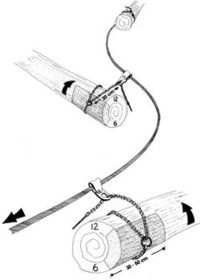 |
| 5.1 How to attach logs on a cable |
Wrap each choker about 40 cm (16 in) from the end of a log. If attaching to the top end, leave stubs to prevent it from sliding off. After wrapping the log, the choker goes through a slider on the mainline.
For the furthest log or logs, attach the hook on the end of the mainline to a special chain on the first slider ( no choker). For the rest, thread the choker rod through the slider on the mainline leaving about 20 cm ( 8 in) between the ring and log.
When wrapping the choker around the log, make sure the ring is on the opposite side from the mainline. This tightens the choker against the log and rolls the log toward the mainline.
Example A
Pauline and Bill have a large tractor and plan to harvest 80 cords of wood per year mostly for sale. They have a good trail network and a D class road that allows a forwarder to collect the wood. They decide to invest in a medium size skidding winch. They can use chokers to pull out several logs at once and then skid them 200 m to where they are piled.
HOW TO WINCH
Trail layout
Before cutting, plan your layout. Extraction trails are not allowed within 7 m (22 ft) of a stream according to Wildlife Habitat and Watercourse Protection Regulations (2002). It is important to check current harvesting regulations. More detail on trail layout and landings is available in Module 11 - Roads and Trails, Planning it Right from the Start.
A well-planned layout ensures that your winch line can reach all the areas you are harvesting. Areas where you plan on harvesting should not be too steep or too wet. Winching allows you to move logs from areas that may be damaged by equipment such as tractors or ATVs.
You can increase production and improve safety by leveling off bumps, cutting stumps low, and using a dozer to scruff the top of main trails. To reduce tractor roll over, do not put trails across slopes, or up slopes more than 35 degrees.
Cable run
The trees are cut along this run. It is best for the runs to be at a diagonal to the trail.
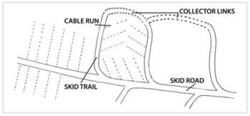 |
| 5.2 Skid trail and skid road system |
Skid trail
The tractor remains on the skid trail when winching. Make your skid trails are 40 to 60 meters apart. This is because the cable can reach in for half of that (30 metres) from each side. The logs may be piled here or skidded out to the skid road.
Collector link
A tractor may not be able to turn around on a skid trail. The link lets the tractor go around the link and get in position to winch out from the cable run. It also lets a trailer be pulled around to collect logs piled on the skid trail if the trail is level enough.
Skid road
The skid trails feed onto the skid road. Logs are piled at landings on the skid road for later pickup or forwarded out by trailer along this road. Note that the cable runs may also exit onto a skid road. Plan landings so they are not more than the maximum skidding or forwarding distance.
How to fell wood for easy winching
Before you start cutting in a certain spot, take some time to figure out where you are going to fell each tree. You want to avoid having to skid over any major obstacles like stumps or rocks.
Fell the trees so the butt end or the top end of the cut log is pointing toward the cable run. This means less turning of the log and less damage to new growth. Drop the top end toward the run when the trees are past the end of the run or off to the side. This lessens the winching distance.
It's also better to winch from the top if there is a lot of brush or obstacles or if you have a large tree. The top end will lift easier because its smaller. You may need to double wrap the choker chain so it doesn't slip off.
Sequence
Work from the back out. This way the brush is behind you and you are not winching through it. You can also use trees that will be cut for bumper trees to protect crop trees.
Winching techniques
In a straight line
Park the tractor on the skid road or trail and lower the three point hitch. Put the tractor in neutral, put on the parking brake, lower the stabilizing legs, and engage the PTO. Pull out the cable to where the log or logs are. Attach the grapple or chain on the end of the cable to the log.
! The angle between the cable and the tractor should not be more than 30 degrees.
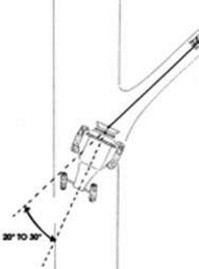 |
| 5.3 Safe skidding angle |
It does not take much to pull over a tractor. If possible, watch someone who has experience winching to learn how to do it safely.
In most cases, the operator stands off to the side of the tractor to manually control the winch. A remote radio-controlled unit can also be used though it is not common. Stand beside the tractor and keep an eye on the log to better control how it moves. It is also a safer place to be in case the cable snaps.
At an angle
Sometimes the log cannot be winched in a straight line. The cable run may not be at a suitable angle. Or the skid trail may be too narrow for the tractor to turn onto with a load.
In this case, a snatch block attached to a tree on the skid trail can be a great help. Position it opposite the cable run. The tractor is parked on the skid trail and the cable is inserted into the pulley and then to the log.
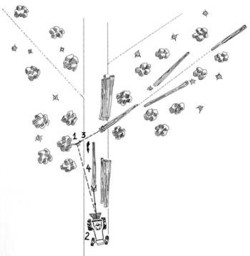 |
| 5.4 Steps in winching with a pulley |
The winch is started and when the log reaches the snatch block, it is released. Further winching pulls the log into line with the tractor. It can then be skidded to the landing or other staging area.
This snatch block method can also be used when there is no winch. The tractor or ATV moves forward to pull the log out instead of winching it.
Protection of remaining trees
Remaining trees can be damaged by skidding, winching or by the equipment. To help prevent this:
- Plan your movements carefully.
- Put a snowmobile track around the trunk of a tree that may be damaged or leave a high stump to act as a deflector.
- Avoid excessive turning with the logs or equipment.
- Skid logs between November and March when the sap is not running.
- Shorten trees to log lengths.
- Use tow lines, not chains, to attach snatch blocks to trees.
Getting unstuck
If the tractor gets stuck while skidding a log, drop the load, drive on a bit and then winch the load back to the tractor. Remember when the load gets stuck is when back flips can occur.
If the log gets stuck, you can:
- Use a snatch block to move the log sideways.
- If the log is not too big, use a felling lever and block of wood to raise the log over the obstacle.
- If moving more than one log, you may have to remove the bottom log and continue to haul the others out and return for the stuck one. Sometimes just removing the top logs will work.
-
Move the tractor so that you can pull from an angle to clear a stump or rock.
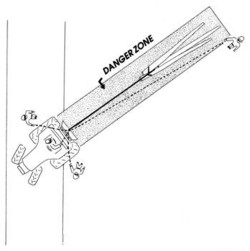
5.5 Danger zone for straight winching 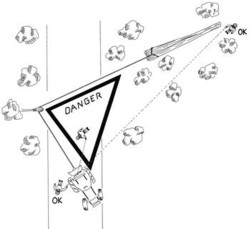
5.6 Danger zone for angled winching
SAFE WINCHING
Operator safety
When winching, it is important to stand outside the danger zone to avoid being hit by a snapped cable or chain.
Cable safety
Use braided Spectra® cable or steel cable for winching. They are both strong and don’t stretch much so there will be less whiplash if it breaks. The Spectra® cable is covered in polyester which makes it safer for your hands and eyes than the steel cable.
Check cables regularly for wear and replace worn ones to PREVENT cable failure.
Cable failure is not very common on farm tractors (unless the cable is worn) as the tractor engine will usually stall if the winch is the right size for the tractor. If not, the tractor will likely upset before the mainline breaks. Chokers are usually the first thing to break.
Protective clothing
Felling trees and winching is hazardous work. You must wear the right clothing to protect yourself from the chainsaw, the cable, falling tress, branches and noise.
Wear:
- Hard hat with ear protectors and face guard (CSA approved)
- Chain saw pants
- Steel toed boots (CSA approved)
- Industrial-quality leather gloves for handling any type of cable or axes
Module Six - Chain Saw Use and Safety has more information on proper clothing.
Further reading on winching ........
Using an All-Terrain Vehicle To Produce Long-Length Logs is a basic guide to skidding with an ATV.
Using a Farm Tractor To Produce Long-Length Logs provides a basic guide to winching with a tractor.
For more detail on tractor safety while winching, site layout and attachments see: Equipping the Farm Tractor for Forest Operations, FERIC Handbook #11.
A useful guide to tractor winches and winching is Forestry Implements for the Farm Tractor , Supplement to FERIC Handbook #11 above.
Specific models of winches and company contacts are provided in Small Scale Woodlot Equipment, a binder produced by the Maritime Woodlot Extension Committee.
The Forest Professional, Guidelines for the Stewards of tomorrow's forests (2001) has a section on Protective Equipment and Clothing.
See Appendix A and B.